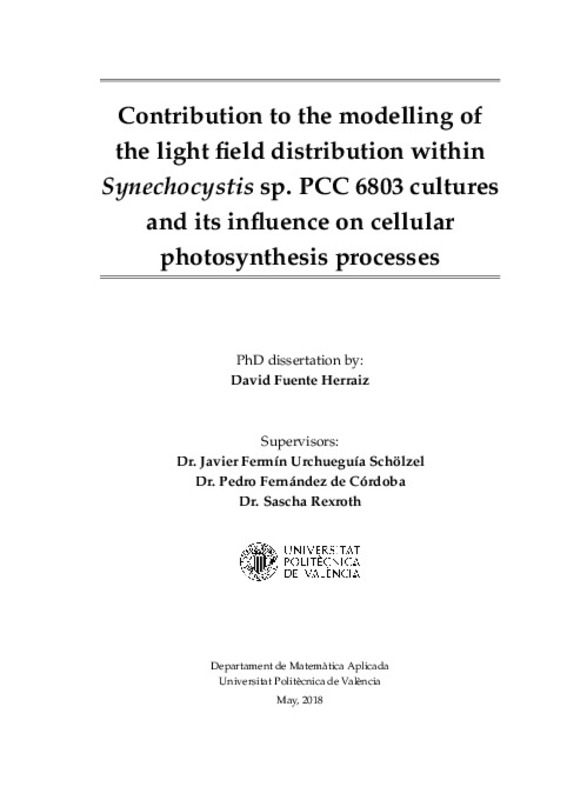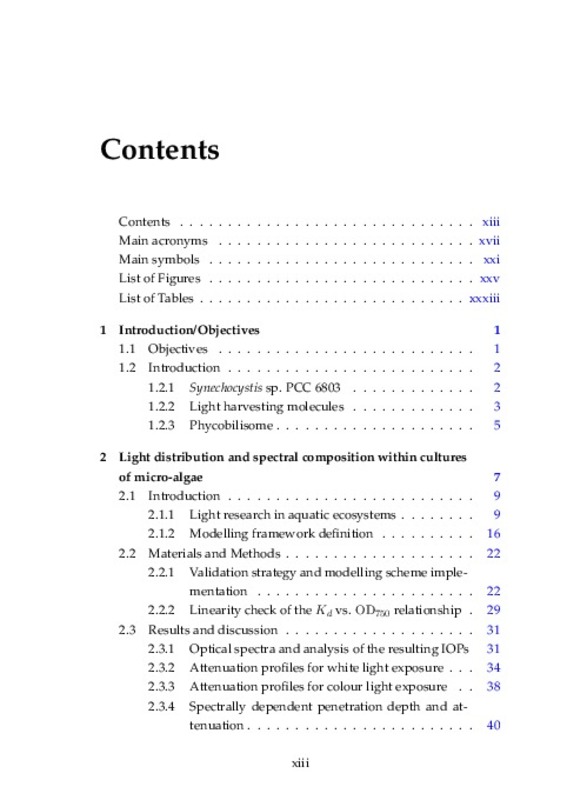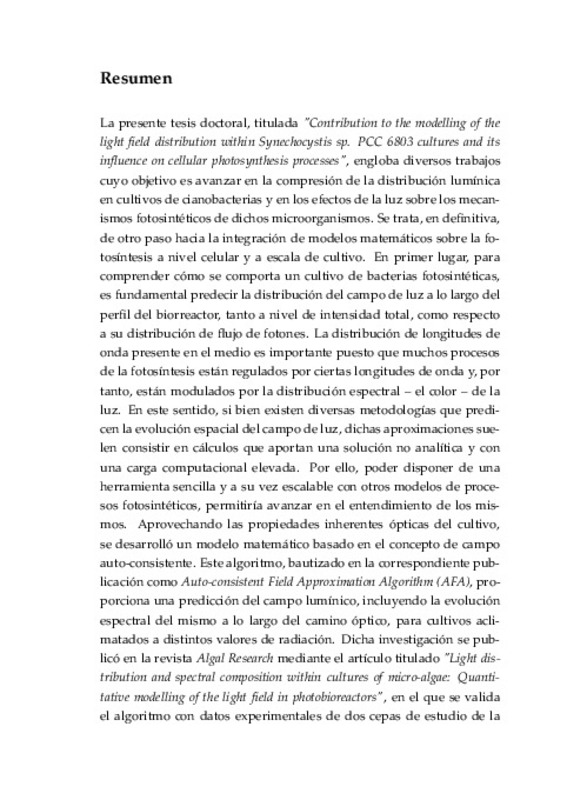- RiuNet repositorio UPV
- :
- Investigación
- :
- Tesis doctorales
- :
- Ver ítem
JavaScript is disabled for your browser. Some features of this site may not work without it.
Buscar en RiuNet
Listar
Mi cuenta
Estadísticas
Ayuda RiuNet
Admin. UPV
Contribution to the modelling of the light field distribution within Synechocystis sp. PCC 6803 cultures and its influence on cellular photosynthesis processes
Mostrar el registro sencillo del ítem
Ficheros en el ítem
| dc.contributor.advisor | Fernández de Córdoba Castellá, Pedro José
|
es_ES |
| dc.contributor.advisor | Rexroth, Sascha
|
es_ES |
| dc.contributor.advisor | Urchueguía Schölzel, Javier Fermín
|
es_ES |
| dc.contributor.author | Fuente Herraiz, David
|
es_ES |
| dc.date.accessioned | 2018-07-30T06:36:08Z | |
| dc.date.available | 2018-07-30T06:36:08Z | |
| dc.date.created | 2018-06-28 | es_ES |
| dc.date.issued | 2019-06-28 | es_ES |
| dc.identifier.uri | http://hdl.handle.net/10251/106362 | |
| dc.description | Tesis por compendio | es_ES |
| dc.description.abstract | La presente tesis doctoral, titulada "Contribution to the modelling of the light field distribution within Synechocystis sp. PCC 6803 cultures and its influence on cellular photosynthesis processes", engloba diversos trabajos cuyo objetivo es avanzar en la compresión de la distribución lumínica en cultivos de cianobacterias y en los efectos de la luz sobre los mecanismos fotosintéticos de dichos microorganismos. Se trata, en definitiva, de otro paso hacia la integración de modelos matemáticos sobre la fotosíntesis a nivel celular y a escala de cultivo. En primer lugar, para comprender cómo se comporta un cultivo de bacterias fotosintéticas, es fundamental predecir la distribución del campo de luz a lo largo del perfil del biorreactor, tanto a nivel de intensidad total, como respecto a su distribución de flujo de fotones. La distribución de longitudes de onda presente en el medio es importante puesto que muchos procesos de la fotosíntesis están regulados por ciertas longitudes de onda y, por tanto, están modulados por la distribución espectral - el color - de la luz. Aprovechando las propiedades inherentes ópticas del cultivo, se desarrolló un modelo matemático basado en el concepto de campo auto-consistente. Este algoritmo, bautizado en la correspondiente publicación como Auto-consistent Field Approximation Algorithm (AFA), proporciona una predicción del campo lumínico, incluyendo la evolución espectral del mismo a lo largo del camino óptico, para cultivos aclimatados a distintos valores de radiación. Dicha investigación se publicó en la revista Algal Research mediante el artículo titulado "Light distribution and spectral composition within cultures of micro-algae: Quantitative modelling of the light field in photobioreactors", en el que se valida el algoritmo con datos experimentales de dos cepas de estudio de la cianobacteria Synechocystis. Si bien los resultados fueron satisfactorios, el empleo de la ley de Lambert-Beer con un valor constante de atenuación no permite modelizar la parte del campo de luz con menor intensidad, donde el coeficiente de atenuación deja de ser constante y el comportamiento se desvía del exponencial. Por ello, se decidió modelizar el campo de luz con una función que generaliza el caso exponencial mediante el uso de cálculo fraccionario. Se empleó una función de Mittag-Leffler que cumplía con los requisitos formales y ofrecía un ajuste de los datos mejor al obtenido mediante la ley de Lambert-Beer. Como un hallazgo notable, se determinó que el valor de dicho parámetro, que caracteriza la función de Mittag-Leffler, era el mismo para los datos empíricos de las dos cepas estudiadas. Este trabajo se publicó en la contribución llamada "Estimation of the light field inside photosynthetic microorganism cultures through Mittag-Leffler functions at depleted light conditions" en la revista Journal of Quantitative Spectroscopy & Radiative Transfer. Después se procedió a utilizar sendos trabajos de investigación para calcular el campo de luz en un cultivo de Synechocystis y relacionarlo con su productividad máxima. En concreto se ha estudiado, como indicador del rendimiento de la fotosíntesis, la producción de oxígeno y los mecanismos respiratorios asociados a distintas intensidades de luz. Esta investigación está en su fase final y se está ultimando la escritura del artículo para enviarlo a una revista científica próximamente. Dicho manuscrito se titula "Experimental characterisation of Synechocystis sp. PCC 6803 cultures productivity up on light conditions". Finalmente, se está desarrollando una cuarta contribución titulada "Individual pigment contribution to overall in vivo absorption in Synechocystis sp. PCC 6803 cells". Esta investigación estudia la cantidad de luz absorbida por los cromóforos de Synechocystis en función del tipo de iluminación utilizada y calcula la concentración de pigmentos presentes en la célula. | es_ES |
| dc.description.abstract | The present doctoral thesis, entitled "Contribution to the modelling of the light field distribution within Synechocystis sp PCC 6803 cultures and its influence on cellular photosynthesis processes", includes several works whose objective is to advance in the understanding of the light distribution in cyanobacterial cultures and in the effects of light on the photosynthetic mechanisms of these microorganisms. It is, ultimately, another step towards the integration of mathematical models on photosynthesis at the cellular level and at the scale of culture. First, to understand how a culture of photosynthetic bacteria behaves, it is essential to predict the distribution of the light field along the bioreactor profile, both at the level of total intensity and with respect to its photon flux distribution. The distribution of wavelengths present in the medium is important since many processes of photosynthesis are regulated by certain wavelengths and are therefore modulated by the spectral distribution - the colour - of the light. Taking advantage of the inherent optical properties of the culture, a mathematical model based on the self-consistent field concept was developed. This algorithm, named in the corresponding publication as Auto-consistent Field Approximation Algorithm (AFA), provides an estimation of the light field, including the spectral evolution thereof along the optical path-length, for acclimated cultures to different radiation values. This research was published in the journal Algal Research through the article entitled "Light distribution and spectral composition within cultures of micro-algae: Quantitative modelling of the light field in photobioreactors", in which the algorithm is validated with experimental data of two strains of study of the cyanobacterium Synechocystis. Although the results were satisfactory, the use of the Lambert-Beer Law with a constant attenuation value, cannot correctly model the part of the light field with less intensity, where the attenuation coefficient ceases to be constant and the behaviour deviates from the exponential. Therefore, it was decided to model the light field with a function that generalizes the exponential case through the use of fractional calculus. A Mittag-Leffler function was used that fulfilled the formal requirements and offered a better data fit than that obtained with the Lambert-Beer law. As a remarkable finding, it was determined that the value of this parameter, which characterises the Mittag-Leffler function, was the same for the empirical data of both studied strains. This work was published in the contribution called "Estimation of the light field in photosynthetic microorganism cultures through Mittag-Leffler functions at depleted light conditions" in the journal Journal of Quantitative Spectroscopy & Radiative Transfer. Thereafter we proceeded to use both research works to calculate the light field within Synechocystis cultures and relate it to its maximum productivity. Specifically, it has been studied, as an indicator of the performance of photosynthesis, the production of oxygen and the associated respiratory mechanisms under different light intensities. This research is in its final phase and the writing of the article is being finalised to submit it to a scientific journal soon. This manuscript is entitled "Experimental characterization of Synechocystis sp. PCC 6803 cultures productivity up on light conditions". Finally, a fourth contribution entitled "Individual pigment contribution to overall in vivo absorption in Synechocystis sp. PCC 6803 cells" is under development. This research studies the amount of light absorbed by Synechocystis chromophores according to the type of employed illumination and calculates the concentration of pigments present in the cell. | en_EN |
| dc.description.abstract | La present tesi doctoral, titulada "Contribution to the modelling of the light field distribution within Synechocystis sp. PCC 6803 cultures and its influence on cellular photosynthesis processes", engloba diversos treballs l'objectiu dels quals és avançar en la compressió de la distribució lumínica en cultius de cianobacteris i en els efectes de la llum sobre els mecanismes fotosintètics d'aquests microorganismes. Llavors, es tracta en definitiva d'un altre pas cap a la integració de models matemàtics sobre la fotosíntesi a nivell cel·lular i a escala de cultiu. En primer lloc, per a comprendre com es comporta un cultiu de bacteris fotosintètics, és fonamental predir la distribució del camp de llum al llarg del perfil del bioreactor, tant a nivell d'intensitat total, com pel que fa a la seua distribució de flux de fotons. La distribució de longituds d'ona present en el medi és important ja que molts processos de la fotosíntesi estan regulats per certes longituds d'ona i, per tant, estan modulats per la distribució espectral - el color - de la llum. Aprofitant les propietats inherents òptiques del cultiu, es va desenvolupar un model matemàtic basat en el concepte de camp auto-consistent. Aquest algoritme, batejat en la corresponent publicació com Auto-consistent Field Approximation Algorithm (AFA), proporciona una predicció del camp lumínic, incloent l'evolució espectral del mateix al llarg del camí òptic, per a cultius aclimatats a diferents valors de radiació. Aquesta investigació es va publicar a la revista Algal Research mitjançant l'article titulat "Light distribution and espectral composition within cultures of micro-algae: Quantitative modelling of the light field in photobioreactors", en què es valida l'algoritme amb dades experimentals de dues soques d'estudi de la cianobacteri Synechocystis. Si bé els resultats van ser satisfactoris, l'ús de la llei de Lambert-Beer amb un valor constant d'atenuació no permet modelitzar la part del camp de llum amb menys intensitat, on el coeficient d'atenuació deixa de ser constant i el comportament es desvia del exponencial. Per això, es va decidir modelitzar el camp de llum amb una funció que generalitza el cas exponencial mitjançant l'ús de càlcul fraccionari. Es va emprar una funció de Mittag-Leffler que complia amb els requisits formals i oferia un ajust de les dades millor a l'obtingut mitjançant la llei de Lambert-Beer. Com una troballa notable, es va determinar que el valor d'aquest paràmetre, que caracteritza la funció de Mittag-Leffler, era el mateix per a les dades empíriques de les dues soques estudiades. Aquest treball es va publicar en la contribució anomenada "Estimation of the light field inside Photosynthetic microorganisme cultures through Mittag-Leffler functions at depleted light conditions" a la revista Journal of Quantitative Spectroscopy & Radiative Transfer. Després, es va procedir a utilitzar sengles treballs d'investigació per calcular el camp de llum en un cultiu de Synechocystis i relacionar-lo amb la seua productivitat màxima. En concret s'ha estudiat, com a indicador del rendiment de la fotosíntesi, la producció d'oxigen i els mecanismes respiratoris associats a diferents intensitats de llum. Aquesta investigació està en la seua fase final i s'està ultimant l'escriptura de l'article per enviar-lo a una revista científica pròximament. Dit manuscrit es titula "Experimental characterisation of Synechocystis sp. PCC 6803 cultures productivity up on light conditions". Finalment, s'està desenvolupant una quarta contribució titulada "Individual pigment contribution to overall in vivo absorption in Synechocystis sp. PCC 6803 cells". Aquesta recerca estudia la quantitat de llum absorbida pels cromòfors de Synechocystis en funció del tipus d'il·luminació utilitzada i calcula la concentració de pigments presents en la cèl·lula. | ca_ES |
| dc.language | Inglés | es_ES |
| dc.publisher | Universitat Politècnica de València | es_ES |
| dc.rights | Reserva de todos los derechos | es_ES |
| dc.subject | Absorption | es_ES |
| dc.subject | Scattering | es_ES |
| dc.subject | Attenuation | es_ES |
| dc.subject | Inherent optical properties | es_ES |
| dc.subject | Modelling | es_ES |
| dc.subject | Synechocystis | es_ES |
| dc.subject | Light field | es_ES |
| dc.subject | Lambert-Beer law | es_ES |
| dc.subject | Mittag-Leffler | es_ES |
| dc.subject | Culture characterisation | es_ES |
| dc.subject | O2 evolution | es_ES |
| dc.subject | Photosynthesis performance | es_ES |
| dc.subject | Pigment concentration | es_ES |
| dc.subject | Package effect | es_ES |
| dc.subject.classification | FISICA APLICADA | es_ES |
| dc.subject.classification | MATEMATICA APLICADA | es_ES |
| dc.title | Contribution to the modelling of the light field distribution within Synechocystis sp. PCC 6803 cultures and its influence on cellular photosynthesis processes | es_ES |
| dc.type | Tesis doctoral | es_ES |
| dc.identifier.doi | 10.4995/Thesis/10251/106362 | es_ES |
| dc.rights.accessRights | Abierto | es_ES |
| dc.contributor.affiliation | Universitat Politècnica de València. Departamento de Matemática Aplicada - Departament de Matemàtica Aplicada | es_ES |
| dc.description.bibliographicCitation | Fuente Herraiz, D. (2018). Contribution to the modelling of the light field distribution within Synechocystis sp. PCC 6803 cultures and its influence on cellular photosynthesis processes [Tesis doctoral]. Universitat Politècnica de València. https://doi.org/10.4995/Thesis/10251/106362 | es_ES |
| dc.description.accrualMethod | TESIS | es_ES |
| dc.type.version | info:eu-repo/semantics/acceptedVersion | es_ES |
| dc.relation.pasarela | TESIS\9858 | es_ES |
| dc.description.compendio | Compendio | es_ES |
Este ítem aparece en la(s) siguiente(s) colección(ones)
-
Tesis doctorales [5389]










